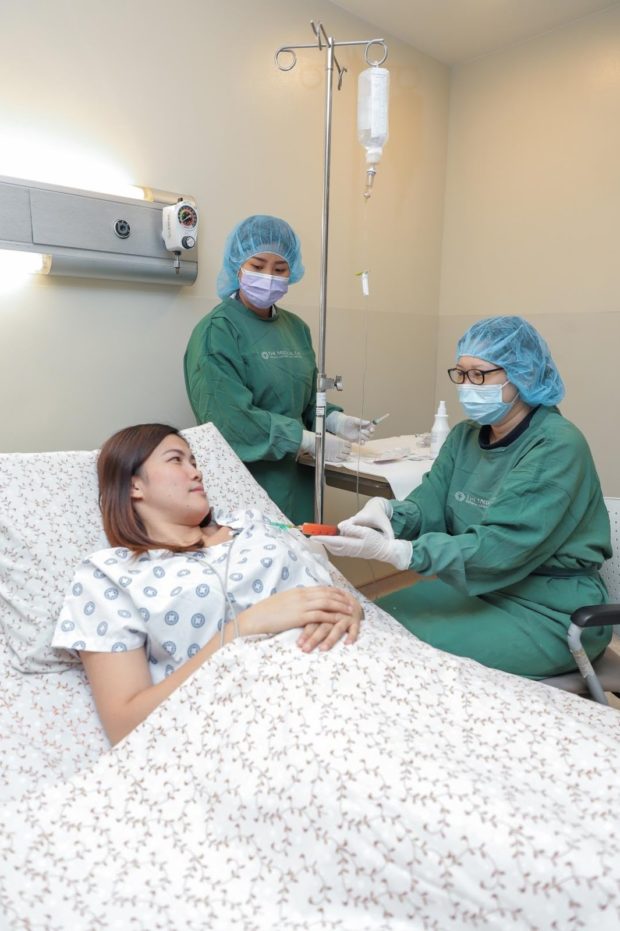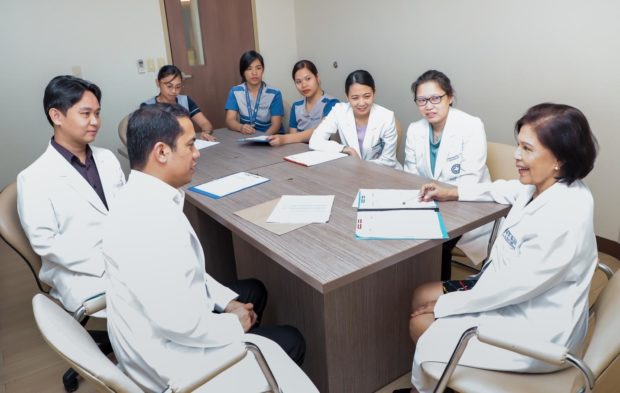
The diagnosis of leukemia has long been a fodder for drama in Hollywood and Filipino movies, a mode of exit in the protagonist’s story that portrays vulnerability, helplessness, and sadness. In real life, the diagnosis has a lot worse impact because the cloak of death dawns not only on people in the prime of their lives but also on young children just beginning to explore the world and the blessings of their families’ love.
High-dose chemotherapy to kill the cancer cells extirpates the bone marrow where blood cells are produced, producing aplasia and crippling the patient’s immune system. Most patients die of overwhelming infections. “Bone marrow rescue” to shorten the period of aplasia requires expert training and experience in isolating, growing, and infusing stem cells from the bone marrow, and huge investment in technology, infrastructure build-up, including sending qualified and willing hematologists, pathologists, med-techs and nurses for specialized training abroad. There is also the need for bone marrow donors, of which difficulty is not unlike the long-standing and still unsolved national problems involving non-related organ donation and procurement for kidney and liver transplantation.
Matching for compatibility between bone marrow donors and recipients (HLA) is expensive; there is no national registry of HLA-tested bone marrow donors, and neither is there a government funding for it. Moreover, importation of stem cells is prohibited by the government, so even if the donor is from a relative who resides abroad, the stems cells cannot be brought into the country.
Indeed, a lot remains to be done at the government level in terms not only of regulatory policies but especially in encouraging and enabling both the public and private health sectors to be at par with – and in fact to be superior to – the best in the world. The Bone Marrow Transplant Program of The Medical City has achieved significant strides in saving lives through its Regenerative Medicine Laboratory, the Institute of Personalized Molecular Medicine (IPMM), and the Augusto P. Sarmiento Cancer Institute (APSCI).
–Dr. Eugenio F. Ramos, TMC President & CEO
Blood cancers in our midst
Though not as common as breast and lung cancers, blood-related neoplasms are burdensome in their own right. There are three major types of blood cancers – leukemia, a debilitating cancer of the blood within the bone marrow; lymphoma, a type of cancer that affects blood cells outside the bone marrow and the lymphatic system, and multiple myeloma, a cancer involving a specific type of blood cells called plasma cells which are responsible for making antibodies.
National incidence data put leukemia as the 8th leading cancer with 5,741 new cases diagnosed in 2018. Non-Hodgkin’s lymphoma is the 12th with an incidence close to 4,000. While multiple myeloma stands at 23rd with a little over 700 newly-diagnosed cases. For the thousands of Filipinos with any of these diseases, a bone marrow transplant may provide their only hope for remission.
Treating blood cancer by transplanting bone marrow
The bone marrow is the principal site for the production of new blood cells. It houses immature cells called hematopoietic stem cells which are capable of developing into one of three cell types: red blood cells or the oxygen-carrying cells, platelets which help blood to clot, and white blood cells, which play a critical role in fending off infection. These specialized progenitor cells are also capable of frequently dividing to adhere to the demands of the body. It is this regenerative property that makes bone marrow very susceptible to cancer therapy.
Radiation and chemotherapy are essential ministrations of cancer care that work by destroying rapidly dividing tumor cells. Since hematopoietic cells also divide more often than most healthy cells, cancer treatment can collaterally destroy the patient’s bone marrow. This depletes the patient’s source of blood cells needed to transport oxygen, prevent bleeding, and keep infections at bay.
The process, known as hematopoietic stem cell transplantation (HSCT) or more commonly, bone marrow transplant, replaces both the cancerous cells and normal stem cells damaged by cancer treatment with donated, healthy cells. The transplanted stem cells embedded within the recipient’s bone marrow can restore the patient’s ability to reproduce blood cells the body needs, allowing the patient to safely receive very higher doses of chemotherapy and radiation therapy. Furthermore, in certain types of blood cancers, there is a graft-versus-tumor (GVT) effect that occurs wherein the white blood cells transplanted from the donor (graft) seek out the remaining tumor cells after chemotherapy, and attack them.

There are two types of bone marrow transplant or HSCT. In an allogeneic transplant, the patient gets blood-forming stem cells from another person – the donor. In an autologous transplant, the patient’s own stem cells are removed from his bone marrow or peripheral blood before the transplant. The cells are stored until they are needed for the transplant. Dr. Alma R. Calavera, hematologist and transplant specialist at The Medical City (TMC), says bone marrow transplant has the potential to cure hematologic malignancies that may be incurable by conventional treatment such as systemic chemotherapy and radiotherapy.
Bone marrow transplant program in the Philippines and The Medical City
The first bone marrow transplant in the Philippines was performed in a government-owned hospital back in 1990. In spite of this early start, only 21 more transplants were done until 2008.
The low number of transplants was largely due to the public’s lack of confidence in the overall capability of local transplant centers and the limited manpower able to do peri-procedural care.
The Medical City has taken a proactive role in line with this, by inaugurating the Institute of Personalized Molecular Medicine (IPMM) in 2012. It is one of only a handful of Human Stem Cell-based therapy programs accredited by the Department of Health – and it involves a multidisciplinary team of specialists that engineer treatment plans tailored to each individual’s medical profile. TMC’s bone marrow transplant program is headed by hematologists Dr. Calavera and Dr. Norma Ona.
It was in 2016 when TMC’s first bone marrow transplant was performed successfully. “Mary,” was 44 years old when she started complaining of bone pains, fatigue, and lightheadedness. She was later diagnosed to have multiple myeloma. After undergoing several cycles of chemotherapy, she underwent bone marrow transplant and tolerated the procedure without any complications. She continues to enjoy her second lease in life, pain-free and in remission up to the present time.
Since then, TMC has performed the procedure a total of 31 times with 97% success rate and 90% overall survival rate. Dr. Calavera credits the impressive outcomes to the multiple sub-specialties involved in preparing the necessary faculties to ensure a precise therapeutic process in inert conditions – “The hospital’s transplant team recognizes that the conditioning phase of preparing the patient prior to infusing stem cells primarily dictates the patient’s eventual clinical course, prognosis and consequently, overall health expenditure. And it has gone through lengths in ensuring a secure, infection-free environment.”

There is a dedicated nursing unit on the 12th floor of the main hospital equipped with positive-pressure rooms specifically designed in coordination with the Hospital Infection Control & Epidemiology Center (HICEC) to prevent contamination. These rooms are manned by nurses experienced in handling immunosuppressed post-transplant patients and are trained to anticipate and report any signs of infection. Only healthcare providers and staff that are thoroughly screened and appropriately vaccinated are allowed to be part of the team that can go in and out of the area.
The IPMM also goes at length to provide a safety net for any foreseeable complications from the patient’s admission until well after discharge. The hospital has a histocompatibility laboratory for necessary matching and tissue typing and harbors equipment and handling protocol for the cryopreservation of hematopoietic stem cells for up to five years. Dr. Calavera also commends the collaborative efforts of the team to ensure a good partnership with the patient: “Our approach to the patient is very personal, holistic and compassionate. We always keep an open door of communication with our patients and their families. Often, an assurance that they are receiving the best, most cost-effective care to support survival, can come a very long way.”
For appointments and inquiries, please call The Medical City Institute of Personalized Molecular Medicine at (632) 988 1000 / (632) 988 7000 ext. 6307 / 6551, or visit www.themedicalcity.com.
ADVT









































